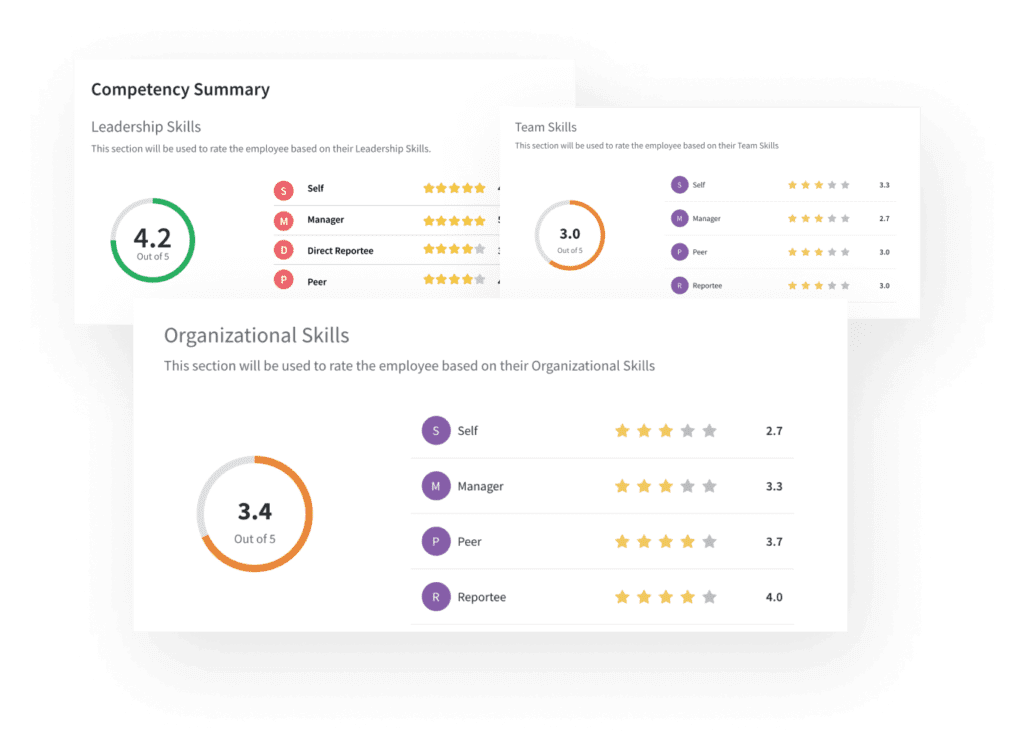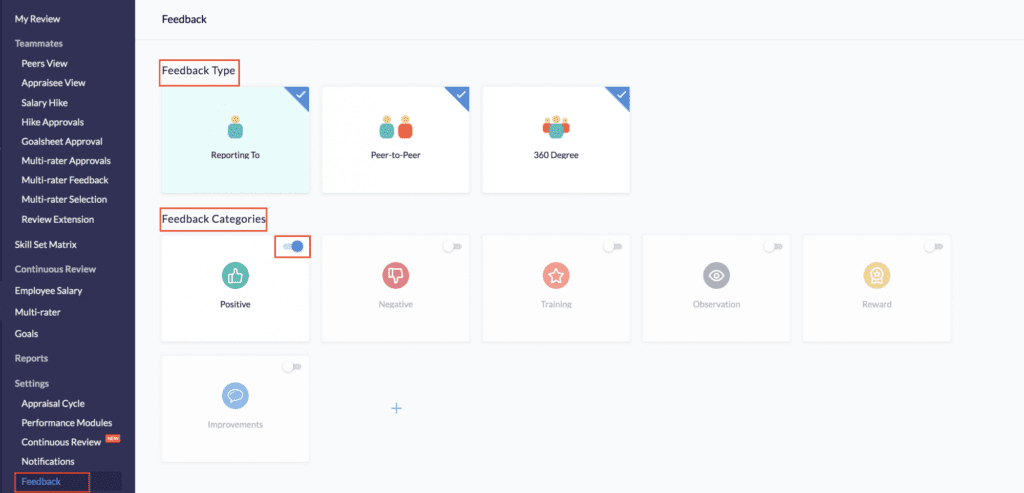Key Takeaways
- 360 Degree Feedback Defined: Understand the essence of 360 Degree Feedback Software, a dynamic tool transforming traditional performance evaluation into a comprehensive and actionable feedback mechanism.
- Strategic Implementation Insights: Navigate the challenges of implementing 360 Degree Feedback Software with real-world examples, ensuring a seamless integration that fosters a culture of continuous improvement.
- Future Trends Unveiled: Explore the horizon of performance management with insights into AI integration, continuous feedback models, and other future trends that promise to reshape the way organizations approach talent development.
In the dynamic realm of modern workplace dynamics, the quest for effective performance management and employee development strategies has given rise to innovative tools and methodologies.
Among these, 360 Degree Feedback Software stands out as a transformative force, reshaping the landscape of how organizations evaluate, nurture, and harness the potential of their workforce.
If you find yourself intrigued by this buzzworthy term but are yet to unravel its intricacies, you’re in the right place.
This comprehensive guide is your gateway to understanding “What is a 360 Degree Feedback Software? Everything You Need to Know.”
Why is Performance Feedback Crucial in the Workplace?
Before delving into the intricacies of 360 Degree Feedback Software, it’s crucial to grasp the fundamental role of performance feedback in contemporary organizational structures.
Beyond the traditional annual reviews, businesses are increasingly recognizing the need for ongoing, holistic assessments that go beyond the immediate supervisor’s viewpoint.
This realization stems from a broader understanding that multifaceted feedback fosters a culture of continuous improvement, aligning individual goals with organizational objectives.
Introduction to 360 Degree Feedback Software: A Paradigm Shift
In the quest for a more comprehensive and nuanced approach to performance evaluation, enter 360 Degree Feedback Software.
At its core, this innovative solution transcends the limitations of traditional, top-down assessments.
It orchestrates a symphony of perspectives, incorporating insights not only from immediate supervisors but also from peers, subordinates, and even external stakeholders.
This holistic feedback mechanism paints a richer portrait of an individual’s strengths, weaknesses, and potential areas for growth, steering away from the one-dimensional evaluation metrics of yesteryears.
Defining 360 Degree Feedback Software: Unpacking the Jargon
What exactly is 360 Degree Feedback Software? Let’s break down the jargon.
In essence, it’s a technology-driven system designed to collect, analyze, and interpret feedback from a spectrum of sources surrounding an employee – hence the term “360 Degree.”
Imagine it as a panoramic lens capturing insights from all angles, providing a more comprehensive and accurate representation of an individual’s performance, skills, and interpersonal dynamics.
How Does 360 Degree Feedback Software Work?
Understanding the inner workings of 360 Degree Feedback Software is pivotal to grasping its transformative potential.
As we navigate through the intricacies of the feedback process, from data collection methodologies to the analytics driving actionable insights, you’ll gain a profound insight into the mechanics that power this cutting-edge performance management tool.
The Crucial Components: Features that Make a Difference
To truly appreciate the power of 360 Degree Feedback Software, one must familiarize themselves with its key components.
From user-friendly interfaces to customizable feedback forms, this section will delve into the features that distinguish exceptional software solutions from the rest.
Whether you’re a seasoned HR professional or a curious entrepreneur, these insights will empower you to make informed choices when selecting the right tool for your organization.
Unlocking the Purpose and Benefits: Why 360 Degree Feedback Matters
Why bother with 360 Degree Feedback Software?
The answers are as diverse as the organizations that adopt this methodology.
From fostering a culture of continuous improvement to enhancing employee engagement, we’ll explore the overarching purposes and myriad benefits that make this tool indispensable for forward-thinking businesses.
Real-world Applications and Case Studies: From Theory to Practice
To anchor theoretical concepts in practical relevance, we’ll journey through real-world applications of 360 Degree Feedback Software.
By examining case studies of organizations that have successfully implemented this tool, you’ll witness firsthand the tangible impact on employee performance, team dynamics, and overall organizational culture.
In the subsequent sections of this extensive guide, we’ll tackle the nuances of selecting the right 360 Degree Feedback Software for your specific needs, strategies for overcoming implementation challenges, and a glimpse into the future trends shaping the evolution of performance management technology.
Buckle up for a comprehensive exploration that transcends the surface, demystifying 360 Degree Feedback Software and equipping you with the knowledge needed to navigate the transformative landscape of modern performance management.
Whether you’re a business leader seeking to optimize your team’s potential or an HR professional navigating the nuances of cutting-edge technology, this guide is your compass in the journey to understanding, implementing, and maximizing the benefits of 360 Degree Feedback Software.
Before we venture further into this article, we like to share who we are and what we do.
About 9cv9
9cv9 is a business tech startup based in Singapore with a strong presence all over the world.
With over seven years of startup and business experience, and being highly involved in connecting with thousands of companies and startups, the 9cv9 team has listed some important learning points in this overview of What is a 360 Degree Feedback Software.
If your company needs recruitment and headhunting services to hire top employees, you can use 9cv9 headhunting and recruitment services to hire top talents and candidates. Find out more here, or send over an email to [email protected].
Or just post 1 free job posting here at 9cv9 Hiring Portal in under 10 minutes.
What is a 360 Degree Feedback Software? Everything You Need to Know
- Defining 360 Degree Feedback Software
- Key Components of 360 Degree Feedback Software
- Understanding the Purpose and Benefits
- How 360 Degree Feedback Software Works
- Choosing the Right 360 Degree Feedback Software
- Overcoming Challenges in Implementation
- Future Trends in 360 Degree Feedback Software
1. Defining 360 Degree Feedback Software: Unpacking the Jargon
In the vast landscape of performance management, the term “360 Degree Feedback Software” has become synonymous with a progressive and inclusive approach to evaluating employee performance.
Let’s delve into the intricacies, breaking down the jargon to understand the essence of this transformative tool.
The Basics of 360 Degree Feedback Software
- Definition: 360 Degree Feedback Software is a technology-driven performance assessment tool that gathers feedback from multiple sources within and outside an organization to provide a holistic view of an individual’s skills, competencies, and behaviors.
- 360 Degree Perspective: The “360 Degree” aspect signifies that feedback is collected from various angles, including superiors, peers, subordinates, and even external stakeholders.

The Multi-faceted Feedback Process
- Data Collection: Utilizing a combination of surveys, questionnaires, and interviews, the software gathers feedback from a diverse set of respondents, ensuring a comprehensive and unbiased evaluation.
- Anonymity: Many 360 Degree Feedback tools maintain respondent anonymity, encouraging more honest and candid assessments, fostering an environment of trust and openness.
The Role of Technology in 360 Degree Feedback
- Automation: These tools leverage automation to streamline the feedback process, reducing administrative burdens and allowing for more frequent and timely assessments.
- Customization: Leading software solutions often offer customization features, enabling organizations to tailor feedback criteria to align with their unique goals and values.
Real-world Examples: Organizations Embracing 360 Degree Feedback
- Google’s Experience: Google is renowned for utilizing 360 Degree Feedback to enhance leadership effectiveness. Their experience showed that employees who received high-quality feedback were more engaged and demonstrated greater improvements in their performance.
- General Electric (GE): GE has a long history of implementing 360 Degree Feedback as a crucial part of their leadership development initiatives. Their success with this approach has influenced many other organizations to adopt similar strategies.

Benefits of 360 Degree Feedback Software
- Comprehensive Evaluation: Enables a more comprehensive evaluation by capturing insights from various perspectives, providing a well-rounded view of an individual’s performance.
- Identifying Blind Spots: Helps individuals identify blind spots and areas for improvement that might not be apparent through traditional top-down evaluations.
- Employee Development: Fosters a culture of continuous improvement, facilitating targeted employee development initiatives based on specific feedback.
Challenges and Considerations
- Feedback Quality: Ensuring the quality and relevance of feedback can be a challenge. Properly designed surveys and clear communication about the purpose of feedback are critical.
- Implementation Hurdles: Organizations may face resistance during the implementation phase. Employee education and change management strategies are vital to overcome such hurdles.
The Data Behind 360 Degree Feedback
- Usage Trends: According to a survey conducted by Deloitte, 90% of Fortune 500 companies use 360 Degree Feedback in their performance management processes.
- Impact on Employee Engagement: A study by Gallup found that organizations with effective feedback systems have 14.9% lower turnover rates.
Looking Ahead: Future Trends in 360 Degree Feedback Software
- Integration with AI and Analytics: The future is likely to see increased integration with artificial intelligence (AI) and advanced analytics, providing more sophisticated insights and predictions.
- Continuous Feedback Models: Anticipate a shift towards continuous feedback models, moving away from traditional annual reviews to more frequent and real-time assessments.
In unraveling the complexities of 360 Degree Feedback Software, we find a powerful tool that goes beyond the conventional boundaries of performance evaluation.
From the methodology of data collection to real-world examples of its successful implementation, this section provides a robust foundation for understanding the essence and impact of 360 Degree Feedback Software in today’s dynamic workplace.
2. Key Components of 360 Degree Feedback Software
In the intricate world of 360 Degree Feedback Software, understanding its key components is essential to harness the full potential of this transformative tool.
Let’s embark on a journey through the essential elements that make up the framework of 360 Degree Feedback Software.
User-Friendly Interface and Accessibility
- Intuitive Design: Leading 360 Degree Feedback Software boasts an intuitive interface, ensuring ease of use for both administrators and participants.
- Mobile Accessibility: With the increasing reliance on mobile devices, software that offers seamless mobile accessibility empowers users to provide and access feedback anytime, anywhere.
Customizable Feedback Forms
- Adaptability: The ability to customize feedback forms is a cornerstone of effective 360 Degree Feedback Software. This allows organizations to tailor questions to specific competencies, goals, or values.
- Scalability: Scalable forms accommodate diverse roles and responsibilities within an organization, ensuring that feedback remains relevant across different levels and departments.
360 Degree Perspective Integration
- Multiple Feedback Sources: A defining feature is the integration of feedback from various sources – supervisors, peers, subordinates, and even external stakeholders – offering a comprehensive view of an individual’s performance.
- Weighted Feedback: Some systems allow for assigning different weights to feedback from various sources, acknowledging the varying impact of different relationships on an individual’s performance.
Real-time Data Collection and Analysis
- Timeliness: The ability to collect and analyze feedback in real-time is a critical component. Real-time data ensures that performance insights are current and actionable.
- Data Visualization Tools: Advanced software often includes data visualization tools, translating feedback into easily digestible graphs and charts for more effective analysis.
360 Degree Feedback Reporting
- Comprehensive Reports: Generating comprehensive reports is a vital function, providing a detailed overview of an individual’s strengths, areas for improvement, and trends over time.
- Individual and Aggregate Reports: Some systems offer both individual and aggregate reports, allowing for a nuanced understanding of both personal growth and broader organizational trends.
Feedback Quality Assurance Features
- Anonymity Safeguards: To encourage open and honest feedback, anonymity safeguards are crucial. This ensures that respondents feel comfortable providing constructive criticism without fear of retribution.
- Validity Checks: Some software incorporates validity checks to ensure the quality and reliability of the feedback collected, filtering out irrelevant or inappropriate responses.
Integration with Performance Management Systems
- Seamless Integration: The ability to seamlessly integrate with existing performance management systems streamlines organizational processes, avoiding redundancies and ensuring a cohesive approach to employee development.
- Data Alignment: Integrated systems allow for the alignment of 360 Degree Feedback data with broader performance metrics, providing a holistic view of individual and team effectiveness.
Training and Support Resources
- User Training: Comprehensive user training resources are vital for successful implementation. They empower administrators and participants to navigate the system effectively.
- Dedicated Support: Access to dedicated support resources, such as customer service or online guides, ensures that organizations can address issues promptly, minimizing disruptions in the feedback process.
Security and Compliance Features
- Data Encryption: Robust security features, including data encryption, protect sensitive information, instilling confidence in both administrators and participants.
- Compliance Measures: Software that adheres to industry compliance standards, such as GDPR or HIPAA, demonstrates a commitment to data protection and privacy.
Cost and Scalability Considerations
- Flexible Pricing Models: Consideration of different pricing models, such as per-user or enterprise-wide licenses, allows organizations to choose a solution that aligns with their budget and scalability needs.
- Scalability Features: As organizations grow, the software’s ability to scale and accommodate an increasing number of users is crucial for long-term viability.
Examples: Leading 360 Degree Feedback Software Platforms
- Trusted by Large Enterprises: Some platforms have gained the trust of large enterprises, offering a comprehensive suite of 360 Degree Feedback tools known for their user-friendly interface and advanced analytics.
- Continuous Innovation: Workday, a leader in HR technology, integrates 360 Degree Feedback seamlessly into its broader suite, emphasizing continuous innovation in the realm of performance management.
The Impact: Data Insights and Organizational Growth
- Quantifiable Improvements: According to a study by the International Journal of Productivity and Performance Management, organizations implementing 360 Degree Feedback experience quantifiable improvements in employee performance, teamwork, and overall organizational effectiveness.
- Cultivating a Feedback Culture: The Harvard Business Review notes that successful adoption of 360 Degree Feedback contributes to cultivating a feedback culture, fostering an environment where continuous improvement is embraced at all levels.
As we dissect the key components of 360 Degree Feedback Software, it becomes evident that these elements form the bedrock of a powerful tool that transcends traditional performance evaluations.
The integration of technology, customization capabilities, and a commitment to data security collectively contribute to the transformative impact of 360 Degree Feedback Software on individual development and organizational growth.
3. Understanding the Purpose and Benefits of 360 Degree Feedback Software
360 Degree Feedback Software serves as a cornerstone in modern performance management strategies, offering a nuanced approach to evaluating employee performance.
Let’s unravel the overarching purpose and delve into the myriad benefits that organizations can reap from embracing this transformative tool.
Purpose of 360 Degree Feedback Software
- Holistic Performance Assessment: The primary purpose is to provide a comprehensive and holistic assessment of an individual’s performance by gathering insights from various perspectives within and outside the organization.
- Developmental Focus: Unlike traditional top-down evaluations, 360 Degree Feedback is inherently developmental, emphasizing continuous improvement and targeted employee growth.
Benefits for Individuals
- Self-awareness: Individuals gain a deeper understanding of their strengths and areas for improvement, fostering self-awareness crucial for personal and professional development.
- Goal Alignment: The feedback obtained helps align personal goals with organizational objectives, ensuring individual efforts contribute to broader strategic initiatives.
- Enhanced Motivation: Recognition of strengths and progress fuels intrinsic motivation, driving individuals to excel in their roles.
Benefits for Teams and Departments
- Improved Collaboration: By fostering a culture of feedback and openness, teams develop stronger communication channels, leading to improved collaboration and synergy.
- Identifying Skill Gaps: Teams can collectively identify skill gaps and areas for improvement, allowing for targeted training initiatives to enhance overall team performance.
Benefits for Organizational Culture
- Feedback Culture: Adopting 360 Degree Feedback contributes to cultivating a feedback culture within the organization, where constructive criticism is valued and integrated into daily operations.
- Retention and Satisfaction: A positive feedback culture contributes to higher employee satisfaction and can impact retention rates positively.
Strategic Organizational Benefits
- Strategic Decision-making: The insights obtained through 360 Degree Feedback inform strategic decision-making processes, allowing organizations to align talent management strategies with overarching business goals.
- Leadership Development: Many successful organizations, such as General Electric, leverage 360 Degree Feedback for leadership development initiatives, identifying and nurturing potential leaders within the company.
Quantifiable Impact on Performance
- Improved Performance: A study published in the International Journal of Productivity and Performance Management found that organizations implementing 360 Degree Feedback experienced significant improvements in employee performance.
- Team Effectiveness: The same study highlighted positive impacts on teamwork, emphasizing the role of 360 Degree Feedback in enhancing overall team effectiveness.
Examples: Organizations Leading the Way
- Microsoft’s Transformation: Microsoft implemented a unique approach to 360 Degree Feedback, focusing on a growth mindset. This shift contributed to the company’s cultural transformation, fostering innovation and collaboration.
- Accenture’s Success: Accenture, a global consulting giant, is known for its robust performance management system, which includes 360 Degree Feedback. This strategy aligns individual and team goals with organizational objectives.

Global Trends and Adoption Rates
- Widespread Adoption: According to a survey by CEB, now Gartner, over 90% of Fortune 500 companies use 360 Degree Feedback in their performance management processes.
- Global Integration: The global adoption of 360 Degree Feedback underscores its universal appeal and effectiveness in diverse organizational cultures and structures.
Challenges and Considerations
- Resistance to Change: Implementation may face resistance from employees uncomfortable with a more transparent evaluation process. Change management strategies are crucial to address this challenge.
- Quality of Feedback: Ensuring the quality and relevance of feedback is a continual challenge. Clear communication about the purpose of feedback and ongoing training can mitigate this concern.
In essence, understanding the purpose and benefits of 360 Degree Feedback Software unveils a strategic tool that not only evaluates individual performance but also contributes to the broader organizational culture and success.
From improved collaboration within teams to quantifiable impacts on performance, the adoption of 360 Degree Feedback Software is a transformative journey toward enhanced employee development and organizational growth.
4. How 360 Degree Feedback Software Works: A Comprehensive Exploration
360 Degree Feedback Software operates as a dynamic mechanism for gathering, analyzing, and utilizing feedback from multiple sources to provide a holistic view of an individual’s performance.
This section will elucidate the intricacies of how this innovative tool functions, examining the processes from data collection to actionable insights.
Data Collection Methodologies
- Surveys and Questionnaires: The primary mode of data collection involves designing surveys or questionnaires tailored to gather insights on specific competencies, behaviors, or skills.
- Multi-rater Input: Respondents, including supervisors, peers, subordinates, and sometimes external stakeholders, contribute their perspectives through the surveys.

Anonymity and Confidentiality Features
- Encouraging Honest Feedback: Many 360 Degree Feedback Software solutions incorporate anonymity features, assuring respondents that their feedback will be confidential. This fosters a culture of open communication and honest input.
- Balancing Transparency: While anonymity is encouraged, transparency about the general themes of feedback, without revealing individual responses, maintains a balance between confidentiality and organizational transparency.
Automation and Real-time Feedback
- Streamlining Processes: Automation plays a crucial role in streamlining the data collection process, reducing administrative burdens and ensuring efficiency.
- Real-time Access: Leading software solutions offer real-time access to feedback, allowing participants and administrators to view and act upon insights immediately, fostering timely development initiatives.
360 Degree Feedback Software Analytics
- Data Interpretation: Analytics tools within the software interpret the collected data, identifying patterns, trends, and areas for improvement.
- Visualizations: Data visualizations such as graphs and charts make complex feedback data more accessible, aiding in the interpretation and communication of insights.
Individual and Aggregate Reports
- Individual Reports: Participants receive detailed reports summarizing their feedback, often organized by competency or skill area, offering insights into their strengths and areas for development.
- Aggregate Reports: Administrators access aggregate reports that provide a holistic view of trends and common themes across teams or the entire organization.

360 Degree Feedback and Performance Metrics Integration
- Aligning Metrics: Integration with broader performance management systems allows for the alignment of 360 Degree Feedback data with key performance metrics, providing a holistic view of individual and team effectiveness.
- Strategic Decision-making: This alignment contributes to informed strategic decision-making, as organizations can correlate feedback data with overall performance indicators.
Feedback Delivery and Actionable Insights
- Delivery Mechanisms: The software facilitates the delivery of feedback through various mechanisms, including written reports, visualizations, and sometimes interactive dashboards.
- Actionable Insights: The ultimate goal is to provide actionable insights, guiding individuals and organizations in developing targeted strategies for improvement.
Examples: Platforms in Action
- Zoho People: Zoho People’s 360 Degree Feedback module is designed to simplify the feedback process. With customizable surveys and real-time analytics, it exemplifies the efficiency of modern 360 Degree Feedback Software.
- Qualtrics: Known for its advanced analytics, Qualtrics’ 360 Degree Feedback tool emphasizes actionable insights, providing a robust example of how technology can enhance feedback processes.

Ensuring Data Security and Compliance
- Encryption Protocols: Data security is paramount, and leading software solutions employ encryption protocols to safeguard sensitive information.
- Compliance Standards: Compliance with industry standards such as GDPR or HIPAA ensures that organizations meet legal and ethical requirements in handling feedback data.
Iterative Feedback Cycles and Continuous Improvement
- Feedback Review Sessions: The software often supports feedback review sessions, facilitating discussions between employees and supervisors to delve deeper into insights.
- Iterative Cycles: Continuous improvement is at the core of 360 Degree Feedback. Iterative feedback cycles allow individuals to track their progress and adjust development strategies accordingly.
Global Adoption Trends
- Global Integration: The widespread use of 360 Degree Feedback is reflected in global adoption trends. According to a study by the Society for Human Resource Management (SHRM), companies around the world are increasingly integrating 360 Degree Feedback into their performance management practices.
- Diverse Industries: This adoption is not confined to specific industries, showcasing the versatility and applicability of 360 Degree Feedback across diverse organizational structures.
Challenges and Considerations
- Ensuring Data Quality: Maintaining the quality of feedback data is a challenge. Implementing validation checks and training participants on providing constructive feedback can mitigate this concern.
- Balancing Transparency: Striking the right balance between transparency and confidentiality is crucial to maintaining trust within the organization.
Understanding how 360 Degree Feedback Software operates unveils a sophisticated process that goes beyond mere data collection.
From ensuring anonymity to delivering actionable insights, this tool is designed to empower organizations in fostering a culture of continuous improvement and strategic talent development.
The integration of technology, analytics, and security features positions 360 Degree Feedback Software as a pivotal player in modern performance management strategies.
5. Choosing the Right 360 Degree Feedback Software: A Comprehensive Guide
Selecting the appropriate 360 Degree Feedback Software is a pivotal decision that can significantly impact the effectiveness of performance management within an organization.
In this comprehensive guide, we will explore the key considerations and criteria to guide you in making an informed choice.
Understanding Organizational Needs and Goals
- Identifying Objectives: Clearly define the objectives and goals for implementing 360 Degree Feedback. Understand whether the primary focus is on individual development, team collaboration, or overall organizational strategy.
- Aligning with Culture: Ensure that the chosen software aligns with the existing organizational culture and values, promoting seamless integration.

Ease of Use and Accessibility
- User-Friendly Interface: Prioritize software with an intuitive and user-friendly interface. This ensures that participants and administrators can navigate the system effortlessly.
- Mobile Accessibility: In today’s mobile-centric world, choose software that offers mobile accessibility, allowing users to provide and access feedback anytime, anywhere.
Customization Features
- Tailored Feedback Forms: Look for software that allows the customization of feedback forms. This feature ensures that the questions align with the organization’s unique competencies and values.
- Scalability: Choose a solution that can scale as your organization grows, accommodating an increasing number of users and evolving feedback needs.
Data Security and Compliance
- Encryption Standards: Prioritize software that employs robust encryption standards to protect sensitive feedback data. Security breaches can have severe consequences, so ensuring the highest level of data security is essential.
- Compliance Measures: Choose software that complies with industry standards such as GDPR or HIPAA, demonstrating a commitment to data protection and privacy.
Integration with Existing Systems
- Seamless Integration: Opt for software that seamlessly integrates with your existing performance management systems. This integration ensures a cohesive approach to talent development and performance evaluation.
- Data Alignment: Integration allows for the alignment of 360 Degree Feedback data with broader performance metrics, providing a comprehensive view.
Cost and ROI Analysis
- Flexible Pricing Models: Consider solutions with flexible pricing models that align with your budget. Whether it’s per-user licenses or enterprise-wide packages, choose a model that suits your financial constraints.
- ROI Considerations: Evaluate the potential return on investment (ROI) by considering the long-term benefits in terms of improved employee performance, engagement, and organizational growth.
Vendor Reputation and Support
- Vendor Track Record: Research the reputation and track record of the software vendor. Consider factors such as customer reviews, case studies, and testimonials to gauge the software’s real-world effectiveness.
- Customer Support: Assess the availability and quality of customer support. A responsive support team is essential for addressing issues promptly and ensuring a smooth implementation process.
Analytics and Reporting Capabilities
- Advanced Analytics: Choose software that offers advanced analytics capabilities. This ensures that the collected feedback is not just data but actionable insights that drive strategic decision-making.
- Visualizations: Data visualizations such as graphs and charts make it easier to interpret complex feedback data, facilitating more informed analysis.
Real-world Examples: Platforms Leading the Way
- Qualtrics: Qualtrics is recognized for its advanced analytics and reporting features, providing organizations with actionable insights. Its customizable surveys and real-time analytics exemplify the efficiency of modern 360 Degree Feedback Software.
- Culture Amp: Culture Amp is known for its emphasis on employee engagement and feedback. Its platform goes beyond traditional surveys, incorporating 360 Degree Feedback to provide a holistic view of employee experience.

User Training and Adoption Strategies
- Comprehensive Training: Choose software that provides comprehensive training resources. Proper user training ensures that administrators and participants can make the most of the software’s features.
- Adoption Strategies: Look for software vendors that offer adoption strategies to support a smooth transition. Strategies may include communication plans, workshops, and ongoing support to encourage consistent usage.
Global Trends and User Reviews
- Global Adoption: Consider the global trends in 360 Degree Feedback Software adoption. Solutions that are widely adopted globally often indicate their effectiveness and versatility across diverse organizational cultures.
- User Reviews: User reviews on platforms provide valuable insights into the real-world experiences of organizations using the software.
Iterative Improvement and Upgrades
- Regular Updates: Opt for software vendors that provide regular updates and improvements. This ensures that the software stays current with industry trends and technological advancements.
- User Feedback Integration: Some platforms actively solicit user feedback for future updates, demonstrating a commitment to meeting the evolving needs of their user base.
Trial Periods and Demos
- Free Trials: Many software vendors offer free trial periods. Utilize these trials to test the software’s functionality, user interface, and compatibility with your organization’s needs.
- Live Demos: Request live demonstrations from potential vendors to get a firsthand look at how the software works and to address any specific questions or concerns.
Choosing the right 360 Degree Feedback Software requires a strategic approach that takes into account organizational objectives, user experience, security measures, and overall alignment with the company’s culture.
By carefully considering each criterion and exploring real-world examples, organizations can make a well-informed decision that propels them toward a more effective and streamlined performance management process.
6. Overcoming Challenges in the Implementation of 360 Degree Feedback Software
Implementing 360 Degree Feedback Software can be a transformative process, but it’s not without its challenges.
Understanding and proactively addressing these challenges is crucial for a successful rollout and sustained utilization of the software within an organization.
Let’s delve into the key hurdles and strategies for overcoming them.
Resistance to Change
- Employee Perception: Resistance to change is a common challenge during the introduction of new systems. Employees may perceive 360 Degree Feedback as a departure from traditional evaluation methods.
- Communication Strategies: Implementing effective communication strategies that highlight the benefits of 360 Degree Feedback and address concerns can mitigate resistance. Communicate the purpose, advantages, and the positive impact it can have on personal and professional development.
Ensuring Data Quality and Relevance
- Quality of Feedback: One challenge is ensuring the quality and relevance of feedback. If respondents provide superficial or biased responses, it can undermine the effectiveness of the system.
- Training Initiatives: Implement training initiatives for participants to educate them on the importance of constructive feedback and how to provide it effectively. Clear guidelines and examples can enhance the quality of responses.
Managing Anonymity Concerns
- Fear of Reprisal: Some individuals may fear reprisal if their feedback is not anonymous. This fear can lead to hesitant or overly positive responses, compromising the authenticity of the feedback.
- Transparency and Safeguards: Emphasize the anonymity safeguards in place and communicate how the system balances transparency and confidentiality. Providing assurance can encourage honest and constructive feedback.
Integration with Organizational Culture
- Cultural Fit: The 360 Degree Feedback Software should align with the existing organizational culture. If there is a disconnect, employees may struggle to integrate the new system into their daily workflows.
- Customization Features: Choose software with customization features that allow alignment with organizational values and competencies. Tailoring the system to fit the existing culture enhances acceptance and integration.
Leadership Buy-in and Participation
- Setting the Tone: Without visible support from leadership, employees may question the legitimacy of the feedback process. Leaders must actively participate and endorse the use of 360 Degree Feedback.
- Training for Leaders: Provide training for leaders on how to interpret and use the feedback effectively. This ensures they understand the process and can set an example for others in the organization.
Addressing Overwhelm and Survey Fatigue
- Survey Overload: In organizations that already conduct various surveys, 360 Degree Feedback may contribute to survey fatigue, impacting the quality of responses.
- Strategic Timing: Strategically plan the implementation to avoid overwhelming employees. Communicate the importance of each survey and how it contributes to the overall development process.
Technology Integration Challenges
- Integration with Existing Systems: Ensuring seamless integration with existing technology infrastructure can be challenging. Incompatibility issues may arise if not addressed proactively.
- Collaboration with IT: Collaborate closely with the IT department to ensure the software integrates smoothly with existing systems. Conduct thorough testing to identify and resolve any compatibility issues.
Clarifying the Purpose and Process
- Lack of Clarity: Employees may struggle to understand the purpose and process of 360 Degree Feedback, leading to skepticism and confusion.
- Educational Initiatives: Implement educational initiatives, such as workshops or webinars, to clarify the purpose, benefits, and the step-by-step process of the 360 Degree Feedback system. Addressing questions and concerns proactively enhances clarity.
Monitoring and Adapting to Feedback
- Continuous Improvement: Feedback should not be a one-way process. Organizations need to actively seek feedback on the effectiveness of the 360 Degree Feedback system and be willing to make adjustments.
- Feedback Loops: Establish feedback loops where employees can provide input on their experience with the system. This creates a culture of continuous improvement and demonstrates a commitment to enhancing the feedback process.
Examples: Successful Implementation Stories
- General Electric (GE): GE has successfully navigated the challenges of 360 Degree Feedback implementation by incorporating the system into its leadership development initiatives. By providing extensive training, emphasizing the importance of feedback, and showcasing real success stories, GE has overcome initial resistance and demonstrated the system’s positive impact.
- IBM’s Strategic Approach: IBM implemented a strategic approach to address anonymity concerns. By clearly communicating the safeguards in place and showcasing how feedback is aggregated to maintain confidentiality, IBM overcame initial skepticism and created a culture of openness.
Global Trends in 360 Degree Feedback Implementation
- Global Adoption: According to Forbes, over 85% of Fortune 500 organizations employ 360-degree feedback as a foundational aspect of their entire leadership development process. This trend underscores the adaptability and effectiveness of the system across diverse cultures and industries.
- Success Stories: Numerous success stories highlight organizations overcoming implementation challenges. Learning from these global trends and success stories can provide valuable insights for navigating challenges effectively.
Measuring the Impact on Organizational Performance
- Quantifiable Metrics: Organizations often struggle with measuring the direct impact of 360 Degree Feedback on overall performance. Quantifiable metrics are essential to demonstrate the system’s effectiveness.
- Longitudinal Studies: Conduct longitudinal studies to track changes in employee performance, engagement, and organizational success after implementing 360 Degree Feedback. Comparative data before and after implementation provides tangible evidence of impact.
Successfully implementing 360 Degree Feedback Software requires a holistic approach that addresses psychological, cultural, and technological factors.
By understanding the potential challenges and adopting proactive strategies, organizations can not only overcome hurdles but also create an environment conducive to continuous improvement and employee development.
The real-world examples and global trends showcased here offer valuable insights for organizations embarking on the journey of implementing 360 Degree Feedback Software.
7. Future Trends in 360 Degree Feedback Software: A Glimpse into Tomorrow’s Performance Management Landscape
As technology evolves and workplaces undergo dynamic transformations, the future of 360 Degree Feedback Software is poised for exciting advancements.
This section explores emerging trends, innovative features, and the potential evolution of this transformative tool.
Integration with Artificial Intelligence (AI)
- Predictive Analytics: The integration of AI will enable 360 Degree Feedback Software to utilize predictive analytics, offering insights into future performance trends and areas for improvement.
- Natural Language Processing (NLP): NLP capabilities can enhance the software’s ability to analyze written feedback, extracting nuanced insights and sentiment analysis for a more comprehensive understanding.
- Example: A pioneering system might use AI to analyze feedback patterns, predict skill gaps, and recommend personalized development plans for employees based on their performance data.
Continuous Feedback Models
- Real-time Assessments: Future 360 Degree Feedback Software is likely to move away from traditional annual reviews, embracing continuous feedback models. This shift allows for real-time assessments, promoting ongoing employee development.
- Agile Performance Management: The Agile methodology, known for its iterative approach, may influence performance management models, fostering adaptability and responsiveness to changing work dynamics.
- Example: Companies adopting continuous feedback models might see improvements in employee engagement and faster response to skill development needs.
Enhanced User Experience and Accessibility
- User-Centric Design: The future will bring a focus on user-centric design, ensuring that 360 Degree Feedback Software is not only functional but also intuitive and engaging for participants.
- Mobile-First Approach: As mobile devices become more ingrained in daily work routines, software providers are likely to adopt a mobile-first approach, allowing users to access and provide feedback on the go.
- Example: A future software update might introduce a gamified interface, making the feedback process more enjoyable and encouraging consistent participation.
360 Degree Feedback for Remote and Hybrid Workforces
- Virtual Collaboration Tools: With the rise of remote and hybrid work, future software solutions may integrate with virtual collaboration tools, facilitating the feedback process for dispersed teams.
- Global Accessibility: Ensuring global accessibility and customization features for diverse cultural contexts will be critical for organizations with geographically dispersed teams.
- Example: A cutting-edge 360 Degree Feedback platform might leverage augmented reality (AR) to create virtual meeting spaces, enhancing the sense of collaboration and connection during feedback sessions.
Emphasis on Employee Well-being and Inclusivity
- Incorporating Well-being Metrics: Future iterations of 360 Degree Feedback Software may include metrics related to employee well-being, recognizing the importance of mental health and work-life balance.
- Diversity, Equity, and Inclusion (DEI) Integration: Software providers may develop features that assess and promote diversity, equity, and inclusion within teams, aligning with the evolving priorities of modern workplaces.
- Example: A forward-thinking software update might include a module that measures team dynamics and inclusivity, providing actionable insights for fostering a positive and inclusive work environment.
Blockchain for Data Security and Transparency
- Enhanced Security Measures: As concerns around data security persist, future trends may see the integration of blockchain technology to enhance the security and transparency of feedback data.
- Immutable Records: Blockchain can create immutable records of feedback, ensuring that once entered into the system, data cannot be altered or tampered with, adding an extra layer of trust.
- Example: A cutting-edge 360 Degree Feedback Software may implement blockchain technology to provide a secure and transparent ledger of feedback data, reassuring participants of the integrity of the process.
Holistic Integration with Employee Development Plans
- Seamless Development Integration: Future software solutions may seamlessly integrate with individualized employee development plans, ensuring that feedback directly influences and informs targeted growth strategies.
- AI-Powered Learning Paths: AI algorithms could analyze feedback data to suggest personalized learning paths, recommending specific training modules or experiences based on identified areas for improvement.
- Example: An innovative platform might offer a one-stop-shop where employees can access their feedback, review personalized development plans, and enroll in relevant training courses, creating a seamless and integrated experience.
Expanded Scope to Include Stakeholder Feedback
- Client and Vendor Perspectives: Future 360 Degree Feedback Software may broaden its scope to include feedback from external stakeholders such as clients, vendors, or partners, providing a more holistic view of an individual’s impact.
- Extended Network Insights: This expansion would capture insights beyond the traditional internal perspectives, offering a more comprehensive understanding of an individual’s contributions and relationships.
- Example: A progressive software update might introduce a feature that enables organizations to collect feedback from clients and incorporate these insights into employee evaluations, fostering a client-centric approach to performance management.
Focus on Actionable Insights and Developmental Roadmaps
- Actionable Feedback: The emphasis will be on providing not just data but actionable insights. Future software versions may prioritize delivering feedback in a way that facilitates tangible and meaningful improvement.
- Developmental Roadmaps: Software may evolve to provide detailed developmental roadmaps, guiding individuals on specific actions and milestones to address identified areas for growth.
- Example: An advanced 360 Degree Feedback platform might introduce a feature that generates dynamic developmental roadmaps based on individual feedback, creating a clear path for continuous improvement.
Environmental, Social, and Governance (ESG) Metrics Integration
- ESG Considerations: The integration of ESG metrics into 360 Degree Feedback Software is a potential future trend. Organizations may use these metrics to assess the social and environmental impact of employee contributions.
- Corporate Social Responsibility (CSR) Alignment: Aligning feedback processes with CSR goals ensures that employee evaluations encompass a broader view of their contributions to the organization and society.
- Example: A forward-thinking platform might introduce a module that allows organizations to evaluate and recognize employees for contributions that align with sustainability and social responsibility objectives.
Global Adoption and Standardization
- Standardized Practices: As 360 Degree Feedback becomes a standard practice in performance management, future trends may involve the standardization of processes and metrics to facilitate global adoption and comparability.
- Industry Collaboration: Collaborations between software providers, industry associations, and regulatory bodies could contribute to the development of standardized practices.
- Example: A future scenario might involve industry leaders collectively establishing standards for 360 Degree Feedback processes, ensuring consistency and reliability across diverse sectors.
Measuring ROI and Organizational Impact
- Advanced Analytics for ROI: Future software updates may introduce advanced analytics specifically focused on measuring the return on investment (ROI) of 360 Degree Feedback initiatives.
- Longitudinal Studies: Organizations may conduct longitudinal studies to assess the long-term impact on employee performance, engagement, and overall organizational success.
- Example: A sophisticated analytics module might provide organizations with real-time insights into the direct correlation between 360 Degree Feedback outcomes and key performance indicators, allowing for informed decision-making.
The future of 360 Degree Feedback Software is promising, marked by technological innovations, a deeper focus on employee well-being and development, and a more holistic approach to performance management.
By staying abreast of these emerging trends and leveraging the capabilities of advanced software solutions, organizations can propel themselves into a new era of performance evaluation that aligns seamlessly with the evolving dynamics of the modern workplace.
Conclusion
In the expansive realm of modern performance management, 360 Degree Feedback Software stands as a beacon of innovation and transformation.
This comprehensive exploration has delved into every facet of this powerful tool, uncovering its purpose, benefits, components, and implementation challenges.
From understanding the intricacies of how it operates to envisioning its future trends, we’ve journeyed through the landscape of 360 Degree Feedback Software to equip you with a holistic understanding.
Unveiling the Core: Defining 360 Degree Feedback Software
In defining 360 Degree Feedback Software, we uncovered its essence – a dynamic mechanism designed to collect feedback from multiple perspectives within and beyond an organization.
It is not merely a tool for evaluation but a catalyst for personal and professional development, fostering a culture of continuous improvement.
Components Unraveled: Key Elements of 360 Degree Feedback Software
Exploring the key components unraveled the intricacies of this tool, from data collection methodologies and anonymity features to analytics-driven insights.
The amalgamation of these elements transforms raw data into actionable insights, steering organizations toward strategic decision-making and enhancing individual and team performance.
Purpose and Benefits: Unleashing the Transformative Power
Understanding the purpose and benefits illuminated the transformative power of 360 Degree Feedback Software.
From improved collaboration within teams to quantifiable impacts on performance, the adoption of this tool transcends traditional performance evaluation, contributing to a positive feedback culture and organizational success.
Implementation Challenges: Navigating the Path to Success
The implementation of 360 Degree Feedback Software comes with its set of challenges.
Resistance to change, data quality concerns, and the need for transparency all demand careful navigation.
By addressing these challenges head-on and learning from successful implementation stories, organizations can pave the way for a seamless adoption process.
Operational Mechanics: How 360 Degree Feedback Software Works
Unveiling the operational mechanics provided insights into the intricate workings of this tool, from data collection and analytics to real-time feedback and integration with performance metrics.
Real-world examples illustrated how leading platforms are leveraging technology to streamline processes and deliver actionable insights.
Choosing Wisely: Navigating the Selection Process
Choosing the right 360 Degree Feedback Software emerged as a critical decision-making process.
The guide emphasized understanding organizational needs, assessing ease of use, considering data security, and evaluating vendor reputation.
Real-world examples showcased platforms leading the way, offering a roadmap for organizations seeking a strategic fit.
Overcoming Challenges: Paving the Path to Success
Implementation challenges, from resistance to change to data quality concerns, require a proactive approach.
By emphasizing the importance of transparency, providing extensive training, and learning from successful cases like GE and IBM, organizations can overcome hurdles and foster a culture of continuous improvement.
The Future Landscape: Trends Shaping Tomorrow’s Performance Management
Our exploration of future trends unveiled a landscape where AI integration, continuous feedback models, and an increased focus on well-being and inclusivity are poised to reshape performance management.
From blockchain for data security to global adoption and standardization, the future promises an era of innovation and enhanced effectiveness.
Final Thoughts: Empowering Organizations for Success
In conclusion, 360 Degree Feedback Software emerges not just as a tool but as a strategic partner in the journey of organizational growth. It empowers individuals to unlock their potential, teams to collaborate synergistically, and organizations to chart a course toward sustained success.
As we navigate the landscape of performance management, the knowledge gained here serves as a compass, guiding organizations toward informed decisions, transformative practices, and a future where continuous improvement is not just a goal but a reality.
If your company needs HR, hiring, or corporate services, you can use 9cv9 hiring and recruitment services. Book a consultation slot here, or send over an email to [email protected].
If you find this article useful, why not share it with your hiring manager and C-level suite friends and also leave a nice comment below?
We, at the 9cv9 Research Team, strive to bring the latest and most meaningful data, guides, and statistics to your doorstep.
To get access to top-quality guides, click over to 9cv9 Blog.
People Also Ask
What is the meaning of 360-degree feedback process?
The 360-degree feedback process is a comprehensive performance evaluation method where an individual receives feedback from various sources, including peers, subordinates, superiors, and self-assessment. This holistic approach provides a well-rounded perspective for personal and professional development.
What is an example of 360-degree feedback system?
An example of a 360-degree feedback system is Qualtrics. It enables individuals to receive feedback from multiple sources, fostering a holistic view of their performance. Customizable surveys, real-time analytics, and actionable insights make it a prominent tool in performance management.
What is a 360 tool?
A 360 tool is a performance evaluation instrument that gathers feedback from multiple perspectives, including peers, supervisors, subordinates, and self-assessment. It provides a comprehensive view of an individual’s skills and behaviors, aiding in personal and professional development.































![Writing A Good CV [6 Tips To Improve Your CV] 6 Tips To Improve Your CV](https://blog.9cv9.com/wp-content/uploads/2020/06/2020-06-02-2-100x70.png)


